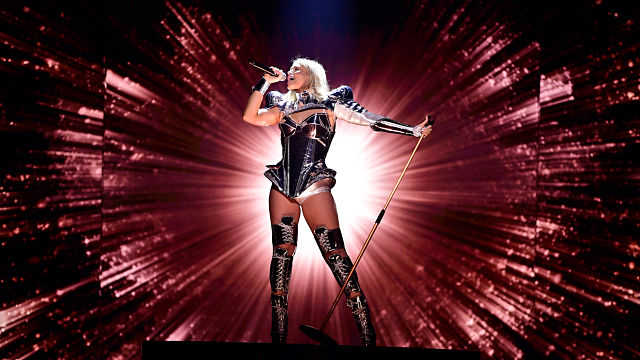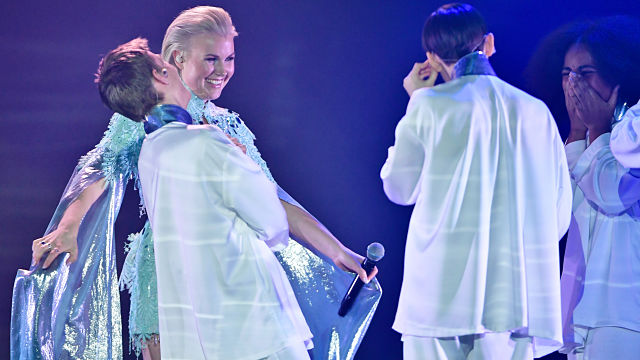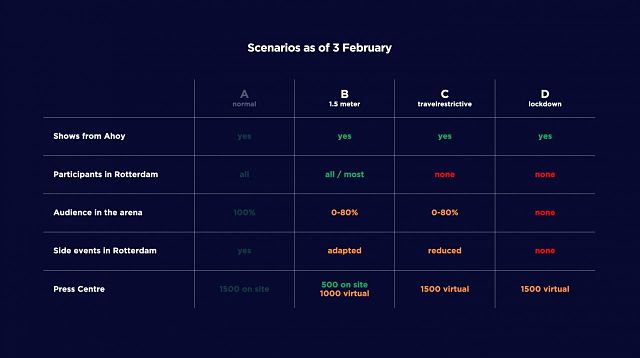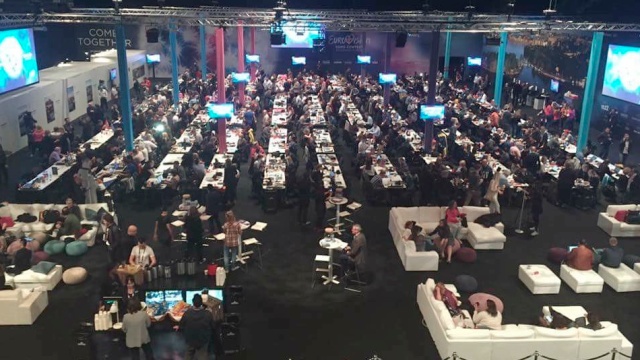Last year I travelled the length of Sweden to cover the whole Melodifestivalen six week tour from start to end. The journey time on the train from Luleå, host of 2020’s third heat, to Malmö the week after was a total of 19 hours.
None of that time-wasting this year.
Regulations in February due to the pandemic meant Swedish broadcaster SVT only allowed a small number of external journalists to cover the event in person, and even they have less access than usual (no viewing the stage directly, for example). Most journalists like myself were covering the competition working from home.
My access to all things Melodifestivalen this year was through the digital platform Mellomedia. Here SVT uploaded all the song information and press materials, ever more important this year as we could not take our own stage photographs. The key new feature for 2021 is that we could also watch rehearsal clips.

Klara Hammarström in rehearsals for the third heat of Melodifestivalen (Photo: Stina Stjernkvist, SVT)
Every Thursday SVT published, just for the press, each act’s third rehearsal from the stage. We can still comment away just like before on all the details of the competing acts and what worked or not to keep the ‘speculation storyline’ flowing. The Friday and Saturday dress rehearsals are also live streamed, which worked flawlessly each week except for one pre-recorded interval act in Heat 4 that was created on the day of the show itself. Even the super secretive song reveal session each Wednesday has transferred to a video conference call – the only time all the journalists got to meet during the week – albeit virtually.
Both time and travel were dramatically saved this year. I no longer had to sit in a random hockey arena all Thursday long to watch seven different rehearsals, instead I could catch up on performances on my Thursday commute home. I no longer needed to arrive a day early to listen to the songs, and I could watch the dress rehearsal in the comfort of my own home.
I was also able to work at much better quality. The clips SVT distributed allowed me to watch as if it was on television, so the comments I made are following the same images we all see on the live show. I was no longer frustrated with conference room speaker systems and instead can plug in headphones for the Wednesday reveal at the quality the songs deserve (indeed, I think my first impression of the songs this year was better because of this). I was also able to tweet through the dress rehearsal in peace and quiet and not squished elbow-to-elbow with other journalists.
I’m not the only one who was singing the praises of the new system. I spoke to Alexander Borodin, the President of Melodifestivalklubben, Sweden’s branch of the OGAE Network. Like every year, Melodifestivalklubben had accreditation access for some of their members to cover each heat, reviewing the songs, tipping who qualifies and interviewing the artists. The change made Melodifestivalklubben’s work far more effective this year.
“Being able to have digital access is an advantage for us. In the past few years we could not get members of the club to easily attend some of the remote locations, such as Skellefteå and Luleå, in time for all of the rehearsals. We previously have had to pay for some of the transport and accommodation for members in the past, and we don’t have that any more.
“Also one of the adaptations this year has been that press contacts have been given out earlier. That has given us more time to organise interviews, and we have been able to organise these interviews on Zoom and let our members join in at the same time.”
On The Other Side Of The Camera
Saving time and money is certainly a benefit of this new system, and for Melodifestivalklubben getting members access to the artists they wouldn’t otherwise have has been a great step forward. However the other measure of distance journalism’s effectiveness must look at the subject of all of the attention and speculation – the artists themselves. Without the press swarming around them in the frantic Melodifestivalen bubble, did their stories still burst through and make the impact they need?
“So far so good” thinks Robert Olausson, the Senior Project Manager for Universal Music Sweden. He is the press contact for many of Universal’s signed artists, including the eventual winner Tusse.

Tusse in rehearsals for Melodifestivalen’s third heat (Photo: Stina Stjernkvist, SVT)
“The biggest comparison is that usually the event and the circus of Melodifestivalen is crowded and loud,” says Robert. “For example now the artists after the show have time and space to calm down before they meet the press.”
“We also have the positive opportunity to do a lot more digitally this year. Tusse has had about 30 interviews for different magazines this week, but we have been able to spread them out over a longer time period.”
The raw number of interviews, Robert explained, is similar to a normal year, and in having more time to conduct them made each one less stressful for each artist and allows the team to prepare better for each interview.
Output may be the same in terms of quantity, but that doesn’t mean that the quality of the artist exposure is necessarily better. On one hand, Robert notes that there was “an increased focus on the performance and the artist” this year, as there were few other moments for the press to discuss without all the usual glitz and glamour alongside the tour. However the lack of a tour this year means that local press coverage, where Melodifestivalen’s arrival can dominate the pages of the local newspaper in a small town, all but disappeared. Linked with that was of course the lost chance to meet fans in person as well.
The Somewhat Staged Digital World
Yes one can do a meet-and-greet via a video call but those connections are rarely the same quality, with plenty of cues and interaction lost talking through screens. Interviews for instance can become stale or bothered by technical challenges. The interviewee may listen to the interviewer but the distance, literal and figuratively speaking, is often further compared to face-to-face. It makes it harder for any journalist to go deeper into a subject and bring out the true feelings and message from the artist.
Indeed the entire media environment had this sterile feeling. I had the rights as a journalist to see what is happening, but I and others only saw the elements that are presented to me by the Swedish broadcaster. The information that I saw is only that which they have agreed to publish – they choose the photos and the clips and I got no choice but to go along with their curated edit of what is happening.

Elisa happy with her dancers before, or maybe after, her Melodifestivalen rehearsal (Photo: Stina Stjernkvist, SVT)
“Rather numb” is how journalist Tobbe Ek described it as, who reported on Melodifestivalen for Sweden’s biggest newspaper Aftonbladet.
“I know that for a lot of the fan journalists, conducting interviews and meeting the artists can be almost as good remotely, even though an interview over video can never be as good as meeting in person.
“But for the larger audience the interviews are rarely what people are interested in. They want actual news based on the event, and without quick encounters or chance meetings they are much harder to come by.”
“The result is that covering Melfest this year is much more static. The broadcaster is in control, and then you can’t be sure that what you get is actually the whole picture.”
Tobbe named one example from the Eurovision world that may have never been witnessed in this new environment. In 2016 Sergey Lazarev was the massive favourite to win the Eurovision Song Contest and his first rehearsal in Globen was one of the most hotly anticipated. On his first run through Sergey climbed the huge wall on stage, slipped and fell.
If we had only seen the final rehearsal of the day, as SVT show this year in Melodifestivalen, we may have never even known that this took place.
Now I have previously raised the ethical question about if we as journalists should see those first rehearsals, but Tobbe’s point here is one that we can all consider regardless. For all of us writing in the fan community, the amount of interest in Sergey’s rehearsal, fall or not, wouldn’t have been significantly different. However for Tobbe, writing to the population at large, rehearsals that go without any hiccup or drama don’t get any attention. Only the dramatic fall made Eurovision rehearsals headline news and a talking point beyond the community.
Those things beyond the everyday and beyond the picture perfect view are the ones that spark the interest and excitement from the world at large. The work that Tobbe does needs to have journalists close enough to see the controversy, drama and mistakes. Those are the things that make those outside of the Eurovision Song Contest bubble stop, pause, and read further. Ultimately it may bring in more people to watch the show on Saturday night.
The Future At The 2021 Song Contest
We know that, regardless of what the final decision will be on the 2021 Eurovision Song Contest, that a digital press centre will be at least a part of the operations. The European Broadcasting Union (EBU) has agreed to work with Let’s Get Digital to create a platform for between 1000 to 1500 journalists to work remotely. Part of the plans include the ability for rehearsals and press conferences to be “followed live for two weeks”.

The three plans remaining for the Eurovision Song Contest 2021 (Photo: NPO/NOS/AVROTROS)
“We are going to make sure that the press will want to stay on the platform for two weeks so that they don’t miss a minute of what is happening at Rotterdam Ahoy,” said Babel Verstappen, the Head of Communications for the Eurovision Song Contest 2021. Journalists are set to receive a digital badge and enter the press centre into a virtual lobby. Once in there will be options to follow rehearsals and the press conferences/meet & greet sessions, with the ability to ask questions via the chat function to still keep it as interactive as possible.
The ESC Communications Team at the EBU further confirmed that delegations will be able to have their own meet & greets via a breakout room function within the digital press centre. A limited number of accreditations, 1500, of which 1000 will be available online, so that every media gets good opportunities to be in touch with the contestants.
My first thought is that such a platform and such a live and interactive feel will help with that problem that Tobbe recognises above. Live images can tell a more truthful tale of what is happening, and having a platform that wants to encourage interaction will help to make the physical distances between press and artists even smaller.
That said, one of the key benefits of the Melodifestivalen system for remote working is that few of the events require you to access the platform live. In only showing the final clips from Thursday’s rehearsals for example removes the need for a whole day of staring at a screen that can be replaced by 21 minutes each Thursday.

The ESC 2016 Press Bunker. Photo: Kylie Wilson
You also have to reckon with the fact that the press working remotely on the Eurovision Song Contest are no longer all in the same time zone, and will be logging in from all corners of the globe. Is it realistic and fair to expect our Australian press members to be working through the middle of the night for two weeks straight? I don’t think it is, or that it should be seen as a goal. The digital world is one that allows opportunities for working wherever and whenever.
In that sense I also wonder and question this goal of having 1000 attendees in a digital press centre, with the same number that would be present otherwise. When one travels to the Song Contest to work as a journalist, one is thrown into an intense working environment. Sessions can be long and journalists may be working over 12 hour days comfortably just watching rehearsal after rehearsal. Is it fair to expect the same level of commitment for journalists working from home as they try to balance covering the Contest alongside other events and, for the fan community, their day-to-day lives? Furthermore, is it healthy to be encouraging being in front of a screen for so long, for any of us.
My instinct here is that perhaps there’s a two tier system that is needed. Not to overload the system and to have the right amount of balance between press and artists, a limit of 1500 ‘live’ might make sense. However access to the resources, materials and clips on demand could be for a greater number. What the majority of the fan community press needs is the ability to view what happens on stage and what is said at press conferences. Interacting with the material live isn’t what everybody needs all the time.
A Future In A Post-Pandemic Song Contest
There will be a time, don’t know where, don’t know when, that the pandemic will subside and the requirement for a digital press centre will no longer be needed. That doesn’t mean that in a future Song Contest it should not exist though.
The pandemic has caused some of the most rapid changes ever in human society. It’s easy and cliché for me to say that life will never be the same again – but things won’t just be going back to normal when this terrible segment of human history is all said and done. Working from home and communicating online has become far more prevalent today and is not about to disappear any time soon. The Eurovision Song Contest is also going to need to adapt to this landscape, and a digital press centre in some format is surely going to be a part of that.
There’s obvious benefits that are the same for all industries around the world. Less travel and therefore less carbon emissions. More flexibility to work where and when you want. It’s also a huge money saver for all – and a part digital/part in-person press centre could reduce physical capacity to ease the burdens on the host broadcaster. That in turn can aid the accessibility of the Song Contest to more demographics – because the time and cost of travelling to the Song Contest can limit which voices get heard.
I also feel the need to be considerate about how a Eurovision Press Centre deals with health. For two weeks people are mixing from across the globe in a reasonably cramped space. We generally survive on snacks for subsistance, not healthy nutrition and the culture is intensely work-hard, play-hard with EuroClub ever a temptation. Plenty of people get ill in this environment, but there’s no opportunity to be involved unless you are present – meaning the press centre is often a place of mass coughing and spluttering by the middle of the second week.
It’s hard to imagine the future right now, but my instinct is that society won’t think this is as OK in May 2022 as it once was in May 2019. Yet at the moment there is no alternative. An accreditation as it is today is a personal tool. If you can’t go to the Press Centre one day the access is lost, which only encourages behaviour where those who should be resting and isolating are inside amongst the crowds. Having a two-tier system, allowing for some digital presence online as a backup, without missing out on everything, seems like an obvious solution. Even if a press centre is smaller, there’s actually an option for a bigger press team this way, but giving these teams the opportunity to have different people present on different days, with others logging in elsewhere.
It all seems so much more 21st century rather than the survival to the finish that covering the Song Contest honestly feels like. I don’t think society is going to simply accept that it is like that any longer.
Final Thoughts
It’s not unusual in the world of Eurovision that Melodifestivalen starts the ball rolling to find solutions. There’s much positive about what has happened, and much to consider about what is lost from this new digital experience. For artists, most of the changes appear to make little difference, but there’s an understanding that it’s harder for journalists to find the headline grabbing stories, and with that, is the show less of a spectacle than it could be?
The plans from the EBU for 2021 feel like they are trying to replicate a real life press centre. Time will tell, but it sounds like both the EBU and Swedish broadcaster SVT have space to learn from each other about effective digital working. We all have been thrown into this at a pace faster than ever before, and solutions are going to keep being developed.
And we will need to develop. The idea that this is a one year only solution is far from reality. Digital working is going to be here to stay in society and the Eurovision Song Contest must continue to be a place at the forefront of technological innovation.









